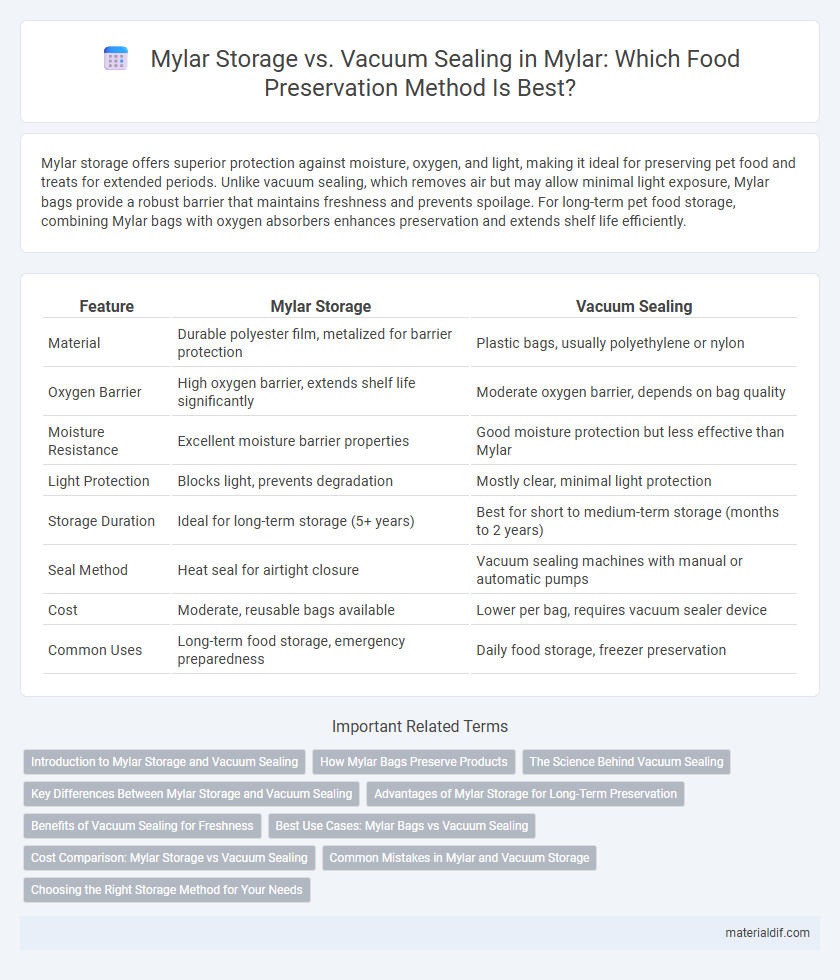Mylar storage offers superior protection against moisture, oxygen, and light, making it ideal for preserving pet food and treats for extended periods. Unlike vacuum sealing, which removes air but may allow minimal light exposure, Mylar bags provide a robust barrier that maintains freshness and prevents spoilage. For long-term pet food storage, combining Mylar bags with oxygen absorbers enhances preservation and extends shelf life efficiently.
Table of Comparison
| Feature | Mylar Storage | Vacuum Sealing |
|---|---|---|
| Material | Durable polyester film, metalized for barrier protection | Plastic bags, usually polyethylene or nylon |
| Oxygen Barrier | High oxygen barrier, extends shelf life significantly | Moderate oxygen barrier, depends on bag quality |
| Moisture Resistance | Excellent moisture barrier properties | Good moisture protection but less effective than Mylar |
| Light Protection | Blocks light, prevents degradation | Mostly clear, minimal light protection |
| Storage Duration | Ideal for long-term storage (5+ years) | Best for short to medium-term storage (months to 2 years) |
| Seal Method | Heat seal for airtight closure | Vacuum sealing machines with manual or automatic pumps |
| Cost | Moderate, reusable bags available | Lower per bag, requires vacuum sealer device |
| Common Uses | Long-term food storage, emergency preparedness | Daily food storage, freezer preservation |
Introduction to Mylar Storage and Vacuum Sealing
Mylar storage uses high-barrier polyester film to protect items from moisture, oxygen, and light, ensuring long-term preservation of food, documents, and valuables. Vacuum sealing removes air from packaging, enhancing shelf life by minimizing oxidation and preventing contamination, often used alongside Mylar bags to maximize freshness. Combining Mylar storage with vacuum sealing creates an optimal environment for extended storage by leveraging the strengths of both methods in moisture and air protection.
How Mylar Bags Preserve Products
Mylar bags preserve products by creating an airtight, moisture-proof barrier that blocks oxygen, light, and contaminants, significantly extending shelf life. These bags resist punctures and maintain a stable environment, preventing spoilage and retaining freshness for years. Compared to vacuum sealing, Mylar storage offers superior protection against UV rays and gas exchange, making it ideal for long-term food preservation.
The Science Behind Vacuum Sealing
Vacuum sealing removes air from the packaging environment, creating an anaerobic condition that slows oxidation and microbial growth, effectively preserving food quality and extending shelf life. Mylar bags, typically made from polyethylene terephthalate (PET), provide a high barrier against light, moisture, and oxygen, but without vacuum sealing, trapped air can still facilitate spoilage. Combining Mylar bags with vacuum sealing optimizes protection by significantly reducing oxygen exposure and preventing moisture infiltration, leveraging both physical barrier properties and reduced gaseous presence for superior long-term storage.
Key Differences Between Mylar Storage and Vacuum Sealing
Mylar storage involves placing items in durable, gas-impermeable bags, often paired with oxygen absorbers to extend shelf life by limiting exposure to oxygen and moisture. Vacuum sealing removes air from packaging, creating a tight seal that prevents contamination and slows swelling but may allow minimal oxygen permeation if not using barrier materials. Mylar bags provide superior barrier protection against light, oxygen, and moisture compared to standard vacuum sealing bags, making them ideal for long-term preservation.
Advantages of Mylar Storage for Long-Term Preservation
Mylar storage offers superior oxygen and moisture barrier properties compared to vacuum sealing, significantly enhancing long-term preservation by preventing oxidation and mold growth. Its durability and resistance to punctures ensure a reliable seal that maintains product integrity over extended periods. Unlike vacuum sealing, Mylar bags enable easy stacking and space efficiency, making them ideal for bulk storage and emergency preparedness.
Benefits of Vacuum Sealing for Freshness
Vacuum sealing preserves freshness by removing air and reducing oxidation, which slows the growth of bacteria and mold compared to Mylar storage. This method extends the shelf life of foods by maintaining optimal moisture levels and preventing freezer burn in frozen goods. Vacuum sealing also enhances flavor retention and nutrient preservation, making it ideal for long-term food storage.
Best Use Cases: Mylar Bags vs Vacuum Sealing
Mylar bags are ideal for long-term food storage, protecting contents from moisture, oxygen, and light, making them perfect for emergency supplies and bulk dry goods such as grains, beans, and dehydrated foods. Vacuum sealing excels in preserving fresh foods by removing air to prevent oxidation and freezer burn, suitable for short to medium-term storage of meats, fruits, and vegetables. Combining Mylar bags with oxygen absorbers enhances shelf life for non-perishable items, while vacuum sealing ensures maximum freshness for perishable foods.
Cost Comparison: Mylar Storage vs Vacuum Sealing
Mylar storage bags typically cost between $0.20 and $0.50 per bag, offering an affordable option for bulk storage compared to vacuum sealing systems that can range from $20 to $200 for machines plus $0.10 to $0.30 per vacuum bag. While upfront costs for vacuum sealers are higher, Mylar bags paired with oxygen absorbers provide a cost-efficient solution for long-term preservation, especially for larger quantities. Over time, vacuum sealing may incur additional costs from machine maintenance and replacement bags, making Mylar storage more budget-friendly for extended food storage.
Common Mistakes in Mylar and Vacuum Storage
Common mistakes in Mylar storage include inadequate sealing, which leads to air and moisture infiltration, compromising the shelf life of stored items. Vacuum sealing errors often involve improper bag selection or incomplete vacuuming, causing partial air retention that accelerates spoilage. Both methods require precise sealing protocols and moisture control to ensure effective long-term preservation.
Choosing the Right Storage Method for Your Needs
Mylar storage provides excellent barrier properties against moisture, oxygen, and light, making it ideal for long-term preservation of dry goods such as grains, seeds, and dehydrated foods. Vacuum sealing removes air to reduce oxidation and spoilage, which is effective for short- to medium-term storage but may not protect against light or punctures. Choosing between Mylar storage and vacuum sealing depends on factors like the type of item stored, desired shelf life, exposure conditions, and budget for optimal protection.
Mylar Storage vs Vacuum Sealing Infographic

 materialdif.com
materialdif.com